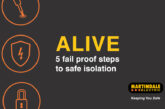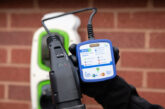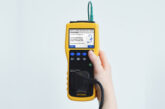
Proving dead effectively and safely is vital when it comes to safe isolation and the safeguarding of people and assets, as Steve Dunning, MD of Martindale Electric, explains.
Proving dead sounds relatively simple, but choosing the right equipment to support the safe isolation process is key. By creating a complete safety system, along with implementing a high level of training and ensuring that a proving unit and lock off kits are always available and used, margin for error is reduced and points of failure are minimised.
What should you be doing?
Firstly, has permission for safe isolation been obtained? If so, identify the point of isolation, lock it off and place warning tags onto the equipment. Lock-off kits are available to ensure that the right locking-off device is always to hand.
A basic lock-off kit should include a selection of MCB and breaker locks, a padlock with a unique key, a hasp (if more than one person is working on a system) as well as lock-out tags and warning labels.
If an accident were to occur, it’s not enough to say that you didn’t have the right device for the breaker because you could isolate the board. If you’re able to turn equipment off but can’t isolate it at the point of connection, trace the supply back to a point where it can be safely locked off. There is no point in proving dead if someone else comes along and restores power without your knowledge.
A major problem encountered when working on existing sites is the lack of comprehensive circuit labelling. Even in cases where circuits appear to be properly labelled, alterations are often made by unqualified or untrained staff. Even if the changes are safe, the labelling may frequently be incorrect.
Voltage indicators
When choosing the right voltage indicator (VI) for a particular application, whether for residential projects, commercial or industrial facilities, reliability is crucial.
Always ensure that the unit you’re purchasing complies with BS EN 61243-3, such as the VI13800 voltage indicator from Martindale Electric, which has been specifically designed to meet this regulation. When choosing the right VI, one of the main factors that set many units apart is a 1000V CAT IV safety rating following BS EN61010, as referenced in BS EN 61243.
It is this safety rating, which ensures the product can cope with the risks from hazardous transient impulses on the mains supply system, which makes indicators such as the Martindale VI15000 and MTL15 suitable for supply-side LV applications in all installation categories as defined in the standard.
That means that wherever you’re working, you can be confident in having a voltage indicator that is properly rated for the application. BS EN61010-1 Installation Categories (CAT ratings) are based on where you’re working.
Test and test again
The next step is to test for dangerous voltages on any circuit conductor to be worked on, whether single or three-phase. It is recommended to use a dedicated proving unit matched to the VI to fully test that all LEDs on all ranges are working. A proving unit is safer than the mains and provides a live source wherever you’re working.
If there is no voltage detected and the circuit is dead, then the operator should proceed to re-test the VI using the proving unit. If it’s working correctly, then the operator has proved dead and the system is safe to commence work.
For increased efficiency, Martindale Electric has introduced complete safe isolation kits, bringing together all the necessary equipment to prove dead and lockout the circuit being worked on.
Browse the Martindale safe isolation kits here









